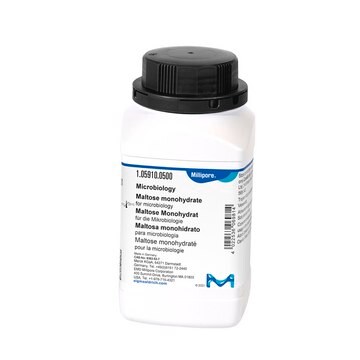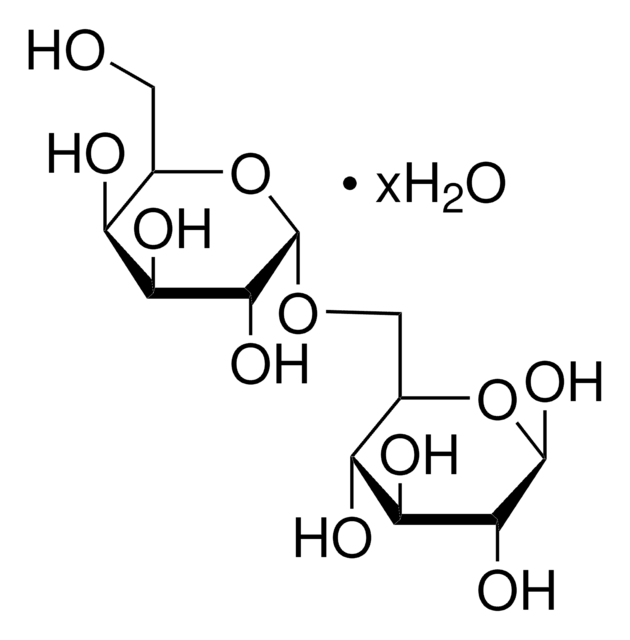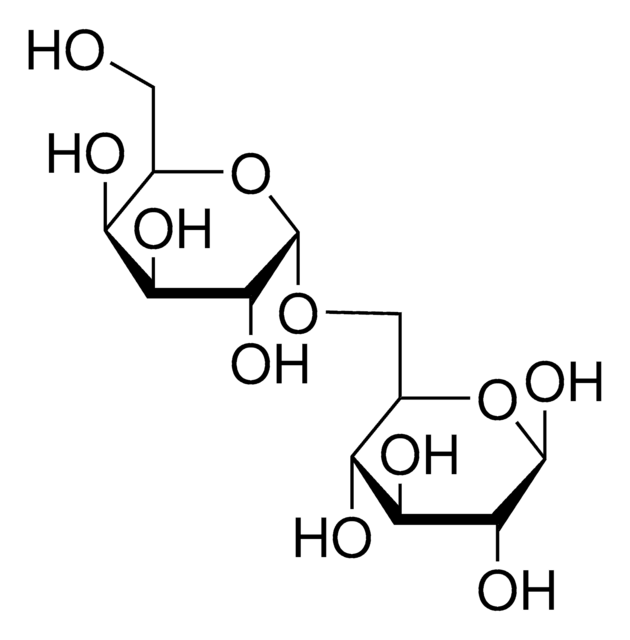C7252
D-(+)-Cellobiose
≥98% (HPLC)
Sinónimos:
β-D-Glc-(1→4)-D-Glc, 4-O-β-D-Glucopyranosyl-D-glucose
About This Item
Productos recomendados
origen biológico
plant
Nivel de calidad
Análisis
≥98% (HPLC)
formulario
powder
actividad óptica
[α]/D 34±1, c = 10% (w/v) in water
técnicas
HPLC: suitable
color
beige
mp
239 °C (dec.) (lit.)
solubilidad
water: 50 mg/mL, clear, colorless
temp. de almacenamiento
room temp
cadena SMILES
OC[C@@H](O)[C@@H](O[C@@H]1O[C@H](CO)[C@@H](O)[C@H](O)[C@H]1O)[C@H](O)[C@@H](O)C=O
InChI
1S/C12H22O11/c13-1-4(16)7(18)11(5(17)2-14)23-12-10(21)9(20)8(19)6(3-15)22-12/h1,4-12,14-21H,2-3H2/t4-,5+,6+,7+,8+,9-,10+,11+,12-/m0/s1
Clave InChI
DKXNBNKWCZZMJT-WELRSGGNSA-N
¿Está buscando productos similares? Visita Guía de comparación de productos
Descripción general
Aplicación
- as a component in test sugar solution for cellobiose-mannitol permeability test
- in the preparation of lyophilization solutions to study its ability to protect lyophilized β-galactosidase from enzymatic activity loss and secondary structure changes during storage
- as a fermentation/growth substrate to grow Clostridium thermocellum to study its impacts on the qualitative and quantitative changes in cellulosome composition
Otras notas
Código de clase de almacenamiento
11 - Combustible Solids
Clase de riesgo para el agua (WGK)
WGK 1
Punto de inflamabilidad (°F)
Not applicable
Punto de inflamabilidad (°C)
Not applicable
Equipo de protección personal
Eyeshields, Gloves, type N95 (US)
Certificados de análisis (COA)
Busque Certificados de análisis (COA) introduciendo el número de lote del producto. Los números de lote se encuentran en la etiqueta del producto después de las palabras «Lot» o «Batch»
¿Ya tiene este producto?
Encuentre la documentación para los productos que ha comprado recientemente en la Biblioteca de documentos.
Los clientes también vieron
Nuestro equipo de científicos tiene experiencia en todas las áreas de investigación: Ciencias de la vida, Ciencia de los materiales, Síntesis química, Cromatografía, Analítica y muchas otras.
Póngase en contacto con el Servicio técnico












